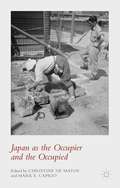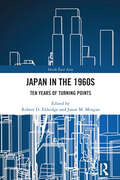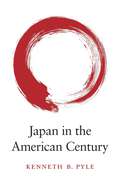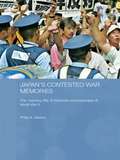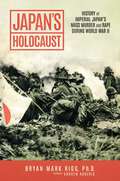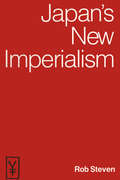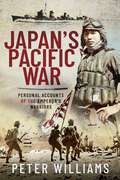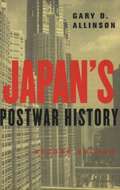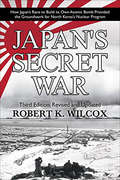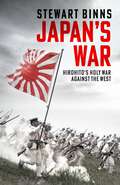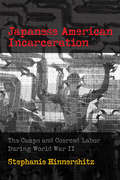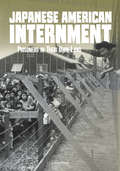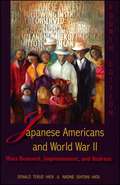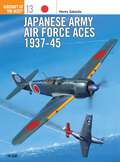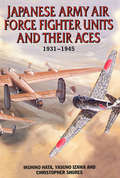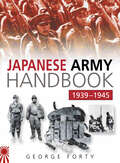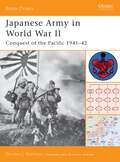- Table View
- List View
Japan and the Great War
by Antony Best Oliviero FrattolilloIn this book, seven internationally renowned experts on Japanese and Asian history have come together to investigate, with innovative methodological approaches, various aspects of the Japanese experience during and after the First World War.
Japan as (Anything but) Number One
by WoronoffA full scale examination of the 1979 Sino-Vietnamese War - the events that led to it, the Cold War aftermath, and the implications for the region and beyond.
Japan as the Occupier and the Occupied
by Christine De Matos Mark E. CaprioThe moment of Japan's defeat in 1945 artificially dissects its history. Not long after the Meiji Restoration, Japan acquired Ezo (present-day Hokkaido) and the Ryukyu Islands (present-day Okinawa). Later in the Meiji Period it annexed Taiwan, southern Sakhalin, and the Korean peninsula. Before the Asia-Pacific War ended in 1945, Japan controlled territories in China, Manchuria, Southeast Asia and the Pacific but with its acceptance of the Potsdam Declaration in August 1945, Japan lost mostof these acquisitions. Examining issues and experiences as part of either a prewar/wartime or postwar context impedes our ability to understand the influence that one period had on the other. How do occupiers maintain their position of power and influence over the people of the state it occupies? How did Japan's leadership and people manage the transition from that of occupier of other territories to that of being occupied by foreign powers? How did this transition affect different aspects of society, from the civilian to the military, the political to the bureaucratic? How did Japanese occupation affect those it had power over, from dissenters to collaborators? What long term impacts did military occupation have on the occupied in terms of memory, commemoration and repatriation? Japan as the Occupier and the Occupied investigates these types of questions by examining transwar transitions in Japan proper and the various territories that it controlled, including Korea, Borneo, Singapore, Manchuria and China. Through taking this approach, a more nuanced understanding of Japan's role as occupier and occupied emerges. More generally, the book contributes to scholarship on the power dynamics of military occupation and the complexities that emerge during, and in the aftermath of, imperial and military expansion, control, and retreat.
Japan at War, 1914–1952 (Seminar Studies)
by Jeremy A. YellenJapan at War, 1914–1952 is a synthetic and interpretive history that highlights the centrality of war to the modern Japanese experience.The author argues that war was central to Japanese life in this period—the era when Japan rose and fell as a world power. The volume examines how World War I set off profound changes that led to the rise of a politicized military, aggressive imperial expansion, and the militarization of Japanese social, political, and economic life. War was extraordinarily popular, which helped confirm Japan’s aggressive imperialism in the 1930s and war across the Asia-Pacific in the 1940s. It took a defeat by 1945 and occupation through 1952 to undo war as a national concern and to remake Japan into a peaceful nation-state. In telling this story of Japan in war and peace, this book highlights the importance of Japan in the creation of the modern world.This study of political power and its influences in domestic and foreign affairs will be of great value to nonspecialist readers who are interested in this period, undergraduate and postgraduate students in introductory classes, and scholars interested in Japanese history and political, military, and international history.
Japan in the 1960s: Ten Years of Turning Points (Inside East Asia)
by Robert D. Eldridge Jason M. MorganEldridge and Morgan set a new paradigm for East Asian contemporary historiography by viewing the decade of the 1960s as hermeneutically powerful. From street battles over Japan’s security treaty with the United States, to a peace treaty with the former Japanese territory of South Korea, to Japan’s hosting the 1964 Summer Olympics, the 1960s in Japan was a decade of turning points. This book is the first to see the 1960s as a historical subject in its own right and argues that the specificity and internal complexity rooted in East Asia during this period showed how East Asians were dynamic agents in shaping the decade. In this volume, contributors consider Japanese responses to a 1961 coup in the Republic of Korea; the Satō Eisaku administration’s approach to nuclear deterrence and to the question of Okinawa’s return from American control; U.S.-Japan intellectual exchange during the Cold War; support by Japanese businesspeople for the Self-Defense Forces; the “soft power” of Japanese cinema in the 1960s; Japan’s understanding of 1960s United Nations peacekeeping operations; changes in “national polity” discourse in the 1960s; the Dalai Lama’s 1967 visit to Japan; economic development in and cultural exchange between 1960s Japan and Spain; Japan’s science and technology interactions with the United States; and the earliest known, and suspected, cases of North Korean abduction of Japanese citizens. Much of the information in this volume has never appeared in English before.This is an important volume for historians, political scientists, sociologists, and other scholars specializing in the twentieth century and those interested in cutting-edge history-writing about a transformative 10-year period in East Asia.
Japan in the American Century
by Kenneth B. PyleNo nation was more deeply affected by America’s rise to power than Japan. The price paid to end the most intrusive reconstruction of a nation in modern history was a cold war alliance with the U.S. that ensured American dominance in the region. Kenneth Pyle offers a thoughtful history of this relationship at a time when the alliance is changing.
Japan's Contested War Memories: The 'Memory Rifts' in Historical Consciousness of World War II (Routledge Contemporary Japan Series #10)
by Philip A. SeatonJapan's Contested War Memories is an important and significant book that explores the struggles within contemporary Japanese society to come to terms with Second World War history. Focusing particularly on 1972 onwards, the period starts with the normalization of relations with China and the return of Okinawa to Japan in 1972, and ends with the sixtieth anniversary commemorations. Analyzing the variety of ways in which the Japanese people narrate, contest and interpret the past, the book is also a major critique of the way the subject has been treated in much of the English-language. Philip Seaton concludes that war history in Japan today is more divisive and widely argued over than in any of the other major Second World War combatant nations. Providing a sharp contrast to the many orthodox statements about Japanese 'ignorance', amnesia' and 'denial' about the war, this is an engaging and illuminating study that will appeal to scholars and students of Japanese history, politics, cultural studies, society and memory theory.
Japan's Economic Planning and Mobilization in Wartime, 1930s-1940s
by Yoshiro MiwaAlthough most economists maintain a (justifiable) mistrust of a government's goals when it intervenes in an economy, many continue to trust its actual ability. They retain, in other words, a faith in state competence. For this faith, they adduce no evidence. Sharing little skepticism about the government ability, they continue to expect the best of governmental intervention. To study government competence in World War II Japan offers an intriguing laboratory. After all, governments direct wars. They decide whether to prepare for them, when to initiate them, how to execute them, and the terms on which to end them. Toward that end, the public sometimes grants them as much power as it can feasibly grant. And in Japan during World War II, the public granted the state the maximum power. In this book, Yoshiro Miwa shows that the Japanese government did not conduct requisite planning for the war by any means. It made its choices on an ad hoc basis, and the war itself quickly became a dead end. That the government planned for the war incompetently casts doubts on the accounts of Japanese government leadership more generally.
Japan's Holocaust: History of Imperial Japan's Mass Murder and Rape During World War II
by Bryan Mark RiggJapan&’s Holocaust is a comprehensive exploration of Japan&’s mass murder and sexual crimes during the Pacific and Asian Wars from 1927 to 1945.Japan&’s Holocaust combines research conducted in over eighteen research facilities in five nations to explore Imperial Japan&’s atrocities from 1927 to 1945 during its military expansions and reckless campaigns throughout Asia and the Pacific. This book brings together the most recent scholarship and new primary research to ascertain that Japan claimed a minimum of thirty million lives, slaughtering far more than Hitler&’s Nazi Germany. Japan&’s Holocaust shows that Emperor Hirohito not only knew about the atrocities his legions committed, but actually ordered them. He did nothing to stop them when they exceeded even the most depraved person&’s imagination, as illustrated during the Rape of Nanking as well as many other events. Japan&’s Holocaust will document in painful detail that the Rape of Nanking was not an isolated event during the Asian War but rather representative of how Japan behaved for all its campaigns throughout Asia and the Pacific from 1927 to 1945.Mass murder, rape, and economic exploitation was Japan&’s modus operandi during this time period, and whereas Hitler&’s SS Death&’s Head outfits attempted to hide their atrocities, Hirohito&’s legions committed their atrocities out in the open with fanfare and enthusiasm. Moreover, whereas Germany has done much since World War II to atone for its crimes and to document them, Japan has been absolutely disgraceful with its reparations for its crimes and in its efforts to educate its population about its wartime past. Shockingly, Japan continues, in general, to glorify is criminals and its wartime past.
Japan's Last Bid for Victory: The Invasion of India, 1944
by Robert LymanEven by SAS standards this is the story of an outstanding warrior.On the point of being demobbed from the SAS, Fred Marafono was recruited by David Stirling for his private security company. After Stirlings death, Fred found himself in the midst of Sierra Leones Blood Diamond wars, and formed an unbreakable bonding with the countrys champion of democracy, Chief Hinga Norman, whose leadership and tragic death are integral to the story.Fred was recruited by Simon Mann for the finest of all private military companies in Africa, Executive Outcomes. Fewer than two hundred of them defeated the rebels in their strongholds. Through political weakness, Executive Outcomes were made to leave the country, and chaos ensued. Committed men like Hinga Norman and British High Commissioner Peter Penfold saw that in the absence of military commitment from the west, only high caliber mercenaries would win the fight to restore democracy: three of them kept a vital air bridge open ? What God abandoned, these defended. Freds final action was supporting the SAS in their brilliant hostage release, Operation Barras.Peter Penfold sums it all up in the books foreword, writing of the, confidence, trust and admiration I have for this remarkable man.
Japan's New Imperialism (Japan In The Modern World Ser.)
by Rob StevenA full scale examination of the 1979 Sino-Vietnamese War - the events that led to it, the Cold War aftermath, and the implications for the region and beyond.
Japan's Pacific War: Personal Accounts of the Emperor's Warriors
by Peter Williams‘I had no qualms fighting the Australians, just as I have killed without remorse any of the Emperor’s enemies: the British, the Americans and the Dutch’, so admits Takahiro Sato in this ground-breaking oral history of Japan’s Pacific War. Thanks to years of research and over 100 interviews with veterans, the Author has compiled a fascinating collection of personal accounts by former Japanese soldiers, sailors and airmen. Their candid views are often provocative and shocking. There are admissions of brutality, the killing of prisoners and cannibalism. Stark descriptions of appalling conditions and bitter fighting blend with descriptions of family life. Their views on the prowess of the enemy differ with some like air ace Kazuo Tsunoda who believed the Australians ‘worthy’. Some remain unrepentant while others such as Hideo Abe are ashamed of his part in Japan’s war of aggression. The result is a revealing insight into the minds of a ruthless and formidable enemy which provides the reader with a fresh perspective on the Second World War.
Japan's Postwar History
by Gary D. AllinsonJapan's Postwar History presents the first integrated analysis of the social, economic, and political changes that Japan has experienced since 1945. Drawing on more than three decades of first-hand experience with the country, Gary D. Allinson depicts a dynamic, often turbulent history and illuminates its impact on individuals, families, and communities. Between 1932 and 1952, war, devastation, and foreign occupation caused significant changes in Japan. However, the society that emerged during the 1950s still resembled its prewar predecessor in many ways, according to Allinson. Thereafter, by exploiting a fortunate combination of domestic and international conditions the Japanese people ushered in twenty years of extensive development. Growth created problems as well as profits and imposed some wrenching adjustments after the world economic crises of 1973 and 1979. Nonetheless, Japanese society steadily assimilated the benefits of affluence, Allinson argues. Until worldwide recession drew Japan into a severe economic downturn in the late 1980s, it continued to adapt to the social and political demands of a rich nation enmeshed in a global economy. By the mid-1990s, Japan had reached the end of a cycle of historical change. Plagued with uncertainty and striving to find a formula for regeneration, Japan once again found itself confronting the dilemmas of inequality, instability, and insecurity.
Japan's Re-emergence as a 'Normal' Military Power (Adelphi series)
by Christopher HughesIs Japan re-emerging as a normal, or even a great, military power in regional and global security affairs? This Adelphi Paper assesses the overall trajectory of Japan’s security policy over the last decade, and the impact of a changing Japanese military posture on the stability of East Asia. The paper examines Japan’s evolving security debate, set against the background of a shifting international environment and domestic policymaking system; the status of Japan’s national military capabilities and constitutional prohibitions; post-Cold War developments in the US Japan alliance; and Japan’s role in multilateral regional security dialogue, UN PKO, and US-led coalitions of the willing. It concludes that Japan is undoubtedly moving along the trajectory of becoming a more assertive military power, and that this trend has been accelerated post-9/11. Japan is unlikely, though, to channel its military power through greatly different frameworks than at present. Japan will opt for the enhanced, and probably inextricable, integration of its military capabilities into the US Japan alliance, rather than pursuing options for greater autonomy or multilateralism. Japan’s strengthened role as the defensive shield for the offensive sword of US power projection will only serve to bolster US military hegemony in East Asia and globally.
Japan's Secret War: How Japan's Race to Build its Own Atomic Bomb Provided the Groundwork for North Korea's Nuclear Program
by Robert K. WilcoxThis groundbreaking investigation reveals how a secret atomic weapons program in WWII Japan led to today’s North Korean security crisis.Japan’s Secret War explores one of the least-known, yet highly significant episodes of World War II: Japan’s frantic race to develop its own atomic bomb. Journalist and historian Robert Wilcox then shows how Japan’s efforts evolved into North Korea’s nuclear program and the looming threat it presents to mankind.After decades of research into national intelligence archives in the US and abroad, Wilcox presents a detailed account of Japan’s version of the Manhattan Project. He traces its development from inception to the possible detonation of a nuclear device in 1945. Wilcox weaves a fascinating portrait of the secret industrial complex where Japan’s atomic research culminated. And it is there that North Korea, following the Japanese defeat, salvaged what remained and fashioned its own nuclear program.“Japan’s Secret War is still spellbinding. It is intriguing and disturbing, and Robert Wilcoxdeserves high praise for his meticulous research.” —Historynet.com
Japan's War: Hirohito’s Holy War Against the West
by Stewart Binns'A superbly revealing account of a dreadful and profoundly sad war' ALASTAIR CAMPBELL'This extraordinary book gives us a unique insight into why and how Japan fought such an appalling war' NICK HEWERA new perspective on Japan during the Asia-Pacific War, using remarkable first-hand Japanese source material.Even after eighty years since the end of a conflict that killed thirty-five million people, there remains deeply-felt bitterness and anger about the way the Asia-Pacific War was fought, especially by the Japanese. The war in the East stretched from Hawaii to India - with Japanese forces attacking Singapore, China and Malaysia, as well as bombing the north coast of Australia. The Allied forces, led by the US, waged an island-by-island counteroffensive that eventually saw the invasion of the Japanese homeland. Japan has been vilified for the countless examples of its cruelty to civilians and prisoners of war. These criticisms have led to a backlash in Japan, where many deny that the accusations are true. By going back to the origins of modern Japan, and by using only Japanese accounts, Japan's War: Hirohito's Holy War against the West offers a powerful account of the conflict and explains in detail why the Japanese conducted the war in the way that they did.
Japan's War: Hirohito’s Holy War Against the West
by Stewart Binns'A superbly revealing account of a dreadful and profoundly sad war' ALASTAIR CAMPBELL'This extraordinary book gives us a unique insight into why and how Japan fought such an appalling war' NICK HEWERA new perspective on Japan during the Asia-Pacific War, using remarkable first-hand Japanese source material.Even after eighty years since the end of a conflict that killed thirty-five million people, there remains deeply-felt bitterness and anger about the way the Asia-Pacific War was fought, especially by the Japanese. The war in the East stretched from Hawaii to India - with Japanese forces attacking Singapore, China and Malaysia, as well as bombing the north coast of Australia. The Allied forces, led by the US, waged an island-by-island counteroffensive that eventually saw the invasion of the Japanese homeland. Japan has been vilified for the countless examples of its cruelty to civilians and prisoners of war. These criticisms have led to a backlash in Japan, where many deny that the accusations are true. By going back to the origins of modern Japan, and by using only Japanese accounts, Japan's War: Hirohito's Holy War against the West offers a powerful account of the conflict and explains in detail why the Japanese conducted the war in the way that they did.
Japan's War: The Great Pacific Conflict
by Edwin P. HoytTracing the history of Japanese aggression from 1853 onward, Hoyt masterfully addresses some of the biggest questions left from the Pacific front of World War II.
Japanese American Incarceration: The Camps and Coerced Labor during World War II (Politics and Culture in Modern America)
by Stephanie D. HinnershitzBetween 1942 and 1945, the U.S. government wrongfully imprisoned thousands of Japanese American citizens and profited from their labor. Japanese American Incarceration recasts the forced removal and incarceration of approximately 120,000 Japanese Americans during World War II as a history of prison labor and exploitation.Following Franklin Roosevelt's 1942 Executive Order 9066, which called for the exclusion of potentially dangerous groups from military zones along the West Coast, the federal government placed Japanese Americans in makeshift prisons throughout the country. In addition to working on day-to-day operations of the camps, Japanese Americans were coerced into harvesting crops, digging irrigation ditches, paving roads, and building barracks for little to no compensation and often at the behest of privately run businesses—all in the name of national security.How did the U.S. government use incarceration to address labor demands during World War II, and how did imprisoned Japanese Americans respond to the stripping of not only their civil rights, but their labor rights as well? Using a variety of archives and collected oral histories, Japanese American Incarceration uncovers the startling answers to these questions. Stephanie D. Hinnershitz's timely study connects the government's exploitation of imprisoned Japanese Americans to the history of prison labor in the United States.
Japanese American Internment: Prisoners in Their Own Land (Tangled History)
by Steven OtfinoskiVivid storytelling brings World War II history to life and place readers in the shoes of the people who experienced the United States' Japanese internment camps. On the heels of Japan's surprise attack on Pearl Harbor in December 1941, President Franklin D. Roosevelt issued Executive Order 9066. Through this order, more than 110,000 people of Japanese descent, many of them U.S. citizens, were forced to relocate to military camps for the duration of the war. Suspenseful, dramatic events unfold in chronological, interwoven stories from the different perspectives of people who experienced these events while they were happening. Narratives intertwine to create a breathless, "What's Next?" kind of read. Students gain a new perspective on historical figures as they learn about real people struggling to decide how best to act in a given moment.
Japanese Americans and World War II: Mass Removal, Imprisonment, and Redress
by Donald Teruo Hata Nadine Ishitani HataLike its predecessors, this fourth edition of "Japanese Americans and World War II" is intended as a succinct and affordable supplement to history and political science texts that minimize or neglect the "Nikkei" (Japanese American) experience in World War II. As was hoped, the first two editions of this publication found an enthusiastic reception by instructors and students alike at the high school, community college, and university level. In addition, the expanded third edition found a new readership beyond the classroom, in members of and visitors to museums, such as the Japanese American Museum in Los Angeles, and interpretive centers at former concentration camp sites administered by the National Park Service at Manzanar, Tule Lake, and others (some in progress). In response to the supportive and constructive feedback of students, instructors, and lay readers, we at Harlan Davidson undertook a bold and sweeping redesign of the third edition that saw our well-loved little "pamphlet" become an attractive but still highly affordable book that, in addition to taking the narrative completely up to date, has been thoroughly re-edited and expanded further to include photographs, key documents, and an enhanced multidisciplinary bibliography of 200 core publications by historians, political scientists, sociologists, anthropologists, and others, as well as multimedia and Internet-based sources. Inaccurate and misleading euphemisms such as "evacuation" and "internment" have been meticulously replaced with more accurate terms like "mass removal" and "imprisonment--changes explained and amplified in a new "Note on Terminology," which explains the movement to correct long out-dated language and refers readers to thoughtful essays on the subject by eminent scholars.
Japanese Army Air Force Aces 1937 - 45
by Henry SakaidaLittle has been published in English on the Japanese Army Air Force (JAAF), let alone its most successful fighter pilots - no less than 150 of them achieved ace status during eight years of near-constant war, and they are all listed in this volume. From the arid plains of the Mongolian border region to the lush jungles of New Guinea, the JAAF was more than a match for the many opponents it fought against for control of the skies. Indeed, even when the mighty Allied war machine proved almost overwhelming from early 1944 onwards, the elite fighter pilots of the various sentais within the JAAF fought on with near-fanatical loyalty in defence of the Home Islands.
Japanese Army Air Force Units and Their Aces, 1931–1945: 1931-1945
by Christopher Shores Yasuho Izawa Ikuhiko HataAn extensive guide to Japan&’s Army Air Force Units and their ace pilots during conflicts in the 1930s and &‘40s, now in English. Commencing with a detailed study of the development, equipment, and operations flown by this force since its inception immediately after the end of World War I, until the catastrophic conclusion of World War II, the initial section deals with the wars in China and Manchuria, as well as the Pacific War of 1941-1945. The second section explores the history of each unit, listing the types of aircraft used, the bases from which they flew, and the unit and formation commanders. Notable mission details are also included. Finally, the third section offers biographical notes for notable fighter pilots and features supporting listings and a glossary of Japanese terms. Photographs of pilots and aircraft are also included, along with line drawings indicating the unit markings carried. This revised edition is a companion volume to Japanese Naval Air Force Fighter Units and Their Aces, 1932–1945.
Japanese Army Handbook 1939-1945: 1939-1945
by George FortyThis is an insight into the most feared army of World War II. The Japanese Imperial Army grew from 1.5 million men in 1939 to 5.5 million men by the end of the war. Their highly successful campaigns in the Far East and the Pacific at the beginning of World War II were every bit as spectacular as those of the Germans in Europe, and they earned an enviable reputation as expert jungle fighters which it took some years for the Allies to match. Their code of honour also made them extremely cruel enemies to prisoners and civilians alike, while their Kamikaze suicidal tendencies meant they would automatically fight to the last without any thought of surrender. Fully illustrated with rare archive photographs, this is a comprehensive study of the army. The author describes how they mobilized and trained their soldiers, and looks at their organizational structures, from high command down to divisional level and below. Also included are uniforms, equipment, all kinds of weapons ranging from tanks and artillery, technical equipment, tactics, symbology and vehicle markings.
Japanese Army in World War II
by Gordon RottmanThe Japanese conquest of the Pacific comprised of a complex series of widely scattered operations; their intent was to neutralize American, Commonwealth, and Dutch forces, seize regions rich in economic resources, and secure an outer defense line for their empire. Although their conquest was successful, the forces deployed from Japan and China were not always ideally trained, equipped and armed. The South Seas and tropics proved challenging to these soldiers who were used to milder climates, and they were a less lethal enemy on the Chinese mainland. This book examines the overall structure of the Imperial Japanese Army (IJA), the forces in existence at the beginning of World War II and the organization of the forces committed to the conquest of the Pacific.


